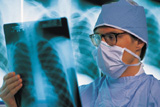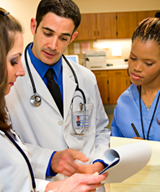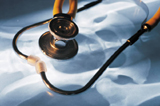Perspective
Becoming a physician
(1)
Notes to the class — first day
I watch the second-year students file into the Ether Dome for their first day of my Patient–Doctor 2 course. For me, this course marks their true entry into medical school. Here, they will refine their history-taking skills, building on their knowledge of pathophysiology and disease; they will learn how to perform a physical examination; and they will touch a living stranger’s body as clinicians for the first time. For them, right now, these are just skills to be learned. They do not see how they will be transformed by them. They know that these newfound abilities will open the door to clinical medicine. They do not know how utterly changed they will be by crossing that threshold. Last year, they took Patient–Doctor 1, which teaches the essential framework of history-taking and interviewing skills, with an emphasis on understanding the patient’s experience. The scuttlebutt is that PD 1 is the ‘soft’ stuff, with its focus on how it feels to be a patient, ill and vulnerable, and its emphasis on self-reflection. They believe that PD 2 is the ‘real’ stuff, the opportunity to start examining patients and taking histories about real disease. They do not understand the importance of what they learned last year, because they do not know how powerful they will become, how patients will hang on their words, how devastating a careless word can be. They do not know how they can ‘do everything right’ and still be ineffective because their behavior has alienated a patient who therefore never returns or does not take necessary medication. How do I convey all this to them while they are still on the other side — where they understand the patient’s perspective more than the doctor’s? Now they are appalled if they see a physician behave rudely or insensitively to a patient. Later, they may behave so themselves. Numerous authors have noted the discrepancy between the values we purport to teach in the ‘explicit curriculum’ and what the students observe and mimic in the ‘implicit curriculum’. Studies suggest that medical students become less compassionate by the end of medical school — that during the process of professional socialization, their original ‘commitment to the well being of others either withers or turns into something barely recognizable’.
In between, they have shifted their focus from the patient to their own learning process. How do I help them to recognize that what they learned last year about the doctor-patient relationship is not just the ‘soft stuff ’, that it is essential?
This is one of my tasks in this course — to try to make it real for them before it actually is real, before they think that the entire purpose of taking a history and performing a physical examination is to develop a diagnostic plan and then a treatment plan, instead of understanding that this is only the beginning of caring for a patient. I want to help them hold onto the patient’s perspective as they turn their attention toward the disease and the challenge of becoming physicians.
I try to do this by using stories about real patients. I think of these stories as tiny vaccines against the loss of compassion that comes from the overwhelming tasks of clinical clerkships, from long hours fraught with anxiety about performing well, about getting the right diagnosis, the right treatment plans, about mastering an enormous amount of knowledge — all of which will direct them toward themselves and each other and away from the patient. I hope these vaccinations will remind them during the long nights ahead that there is always a person attached to the disease and that giving comfort is one of their fundamental tasks.
— Katharine Treadway, M.D 1
(2)
The students settle down in their new white coats. There is nervous laughter. This is not the comfortable classroom atmosphere with which they are familiar. We begin, we make introductions. We discuss the course goals. We emphasize the importance of mastering the skills we will teach them: these are the fundamental tools of the clinician, and patients’ lives will depend on their mastery of these skills.
Then I begin my first story.
“When I was a third-year medical student doing my pediatric rotation, I was walking down the hospital corridor with my intern one night, making rounds on the recent admissions. He stopped at the door of a patient whom I knew was not on our service, but he said, ‘I need to see this patient and her family. I know them because she has been here several times this year.’ When we walked into the room, I saw a seven-year-old girl lying on a bed. She was breathing the loud, liquid breaths I would come to know as the death rattle. Her skin was brilliant yellow, her abdomen massively swollen from the Wilms’ tumor that was killing her. She had no hair — the effects of her many bouts of chemotherapy — and her limbs were stick-thin. With her were her parents and both sets of grandparents. When we walked in, her mother stood up. My intern walked over to her and put his arms around her, and they stood, silently, holding each other. After a few minutes, the mother stepped back and, looking at her daughter, at the unbearable scene before her, said, ‘You know, I never thought I would want her to die, but I want her to die. Somehow, when they said there was nothing more they could do, I pictured her in a field of flowers and she’d just be gone. I never thought it would be like this.’”
The students sit quietly, listening. I continue.“My intern taught me a profoundly important lesson that night. Many doctors would have walked by that door because everything had been done. The diagnosis had been made, the correct treatment given, the complications appropriately treated, and now the girl was dying and there was nothing more to do. What my intern taught me that night was that there was one more thing to do — to go into that room and offer whatever comfort his care and concern could bring, to bear witness to the pain of that family. In the end, it was as important as anything else that had been done for that child. In the long years ahead, if you asked the mother what she remembered of that time, I suspect that one memory would be of my intern holding her. The lesson he taught me was that in the practice of medicine, the person you are is as important as what you know.”
This is one of the extraordinary things about medicine, I say: it is an intensely intellectual endeavor, demanding that you learn and understand an enormous body of information and that you constantly update that information as new knowledge becomes available, but it is also an endeavor of your heart. At the same time that you are learning about disease and diagnosis and treatment, you are learning about illness, the patient and yourself. I have now given these students their first inoculation in this course. I can only hope that it will take 2.
— Coulehan J., Williams P.C.
Courtesy: N Engl J Med. March 24, 2005; 352:12, www.nejm.org, 1176.
1. Dr. Treadway is Assistant-Professor of Medicine at Harvard Medical School and Massachusetts General Hospital, Boston.
2.Coulehan J., Williams P.C. Vanquishing virtue: the impact of medical education. Acad Med 2001;76:598-605.
Share with us (Comments,contributions,opinions)
When reproducing this feature, please credit NAMAH,and give the byline. Please send us cuttings.



